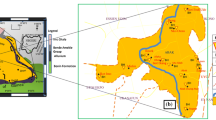Abstract
Water scarcity is one of the major concerns that people are facing worldwide. Although the liquid is absolutely abundant through the globe, its availability poses too much problems specifically to each region. Those problems can result in one or a combination of three basic situations: declining water (drought), overabundance of surface water (floods) or degradation of the quality of water (pollution). All these situations are reflected in the scarcity of good quality water. Arid regions are particularly concerned. In such areas where groundwater contained in aquifers is usually perceived as providence, any project of groundwater exploration and exploitation must be preceded by prior careful and meticulous investigation, in order to avoid early and premature drying. This investigation is likely to predict the future behaviour of aquifers and to improve the groundwater resources management. Beside fundamental properties as hydraulic conductivity, the present paper that addresses the water sector in the semi-arid region of northern Cameroon emphasizes the importance of porosity on aquifer productivity and consequently on the groundwater resources management. The porosity of the local aquifer has then been determined using the Waxman and Smits model which establishes a reliable relationship between the apparent and corrected formation factors, F a and F c , taking the clay effects into consideration. This approach can be applied in other similar semi-arid regions through the world.





Similar content being viewed by others
References
Al-Assa’d TA, Abdulla FA (2010) Artificial groundwater recharge to a semi-arid basin: case study of Mujib aquifer, Jordan. Environ Earth Sci 60:845–859. doi:10.1007/s12665-009-0222-2
Anomohanran O (2013) Geophysical investigation of groundwater potential in Ukelegbe, Nigeria. J Appl Sci 13:119–125
Archie GE (1942) The electrical resistivity log as an aid in determining some reservoir characteristics, Petroleum Technology. Techno Publishing, New York
Arétouyap Z, Njandjock Nouck P, Bisso D, Ekoro Nkoungou H, Meli’i JL, Lepatio Tchieg AS (2014a) Investigation of groundwater quality control in Adamawa-Cameroon region. J Appl Sci 14(19):2309–2319. doi:10.3923/jas.2014.2309.2319
Arétouyap Z, Njandjock Nouck P, Bisso D, Nouayou R, Lengué B, Lepatio Tchieg A (2014b) Climate change and its possible interactions with water resources in Central Africa. J Appl Sci 14(19):2219–2233. doi:10.3923/jas.2014.2219.2233
Arétouyap Z, Nouayou R, Njandjock Nouck P, Asfahani J (2015) Aquifers productivity in the Pan-African context. J Earth Syst Sci 124(3):527–539
Asfahani J (2007) Electrical earth resistivity surveying for delineating the characteristics of ground water in semi-arid region in the Khanasser Valley, Northern Syria. Hydrol Process 21(8):1085–1097. doi:10.1002/hyp.6290.2012
Asfahani J (2012) Quaternary aquifer transmissivity derived from vertical electrical sounding measurements in the semi-arid Khanasser valley region, Syria. Acta Geophys 60(4):1143–1158
Asfahani J (2013) Groundwater potential estimation deduced from vertical electrical sounding measurements in the semi-arid Khanasser Valley region, Syria. Hydrol Sci J 58:468–482
Bejranonda W, Koch M, Koontanakulvong S (2013) Surface water and groundwater dynamic interaction models as guiding tools for optimal conjunctive water use policies in the central plain of Thailand. Environ Earth Sci 70:2079–2086. doi:10.1007/s12665-011-1007-y
Jocson JMU, Jenson JW, Contractor DN (2002) Recharge and aquifer response: northern guam lens aquifer, Guam, Mariana Islands. J Hydrol 260:231–254
Jones IC, Banner JL, Humphrey JD (2000) Estimating recharge in a tropical karst aquifer. Water Resour Res 36(5):1289–1299
Meinzer OE (1923) Outline of ground-water hydrology with definitions. US Geological Survey Water Supply, p 494
Pérez JJ, Sanz E (2011) Hydrodynamic characteristics and sustainable use of a karst aquifer of high environmental value in the Cabrejas range (Soria, Spain). Environ Earth Sci 62:467–479. doi:10.1007/s12665-010-0540-4
Radfar M, Van Camp M, Walraevens K (2013) Drought impacts on long-term hydrodynamic behaviour of groundwater in the tertiary–quaternary aquifer system of Shahrekord Plain, Iran. Environ Earth Sci 70:927–942. doi:10.1007/s12665-012-2182-1
Tchameni R, Mezger R, Nsifa NE, Pouclet A (2001) Crustal origin of Early Proterozoïc Syenites in the Congo (Ntem Complex), South Cameroon. Lithos 57:78–92
Toteu SF, Ngako V, Affaton P, Nnange JM, Njanko TH (2000) Pan-African tectonic evolution in central and southern Cameroon: tranpression and transtension during sinistral shear movements. J Afr Earth Sci 36:207–214
Vincent PM (1970) Conséquences tectoniques de la présence d’un métamorphisme crétacé au Cameroun. Annuaire Faculté des Sciences de l’Université de Yaoundé 2:431–434
Vinegar HJ, Waxman MH (1984) Induced polarization of shaly sands. Geophysics 49(8):1267–1287. doi:10.1190/1.1441755
Waxman MH, Smits LJM (1968) Electrical conductivities in oil-bearing shaly sands. SPE J 8(2):107–122. doi:10.2118/1863-A
Worthington PF (1993) The uses and abuses of the Archie equations: the formation factor-porosity relationship. J Appl Geophys 30(3):215–228. doi:10.1016/0926-9851(93)90028-W
Zohdy AAR (1989) A new method for the automatic interpretation of Schlumberger and Wenner sounding curves. Geophysics 54:245–253
Acknowledgements
The authors are very thankful to the Editor-in-Chief, Prof. James W. LaMoreaux, and to both anonymous reviewers who helped us to significantly improve the quality of this paper. The first author would like to thank Prof. Ibrahim Othman, General Director of the Syrian Atomic Energy Commission for allowing Prof. Jamal Asfahani to join the research team that conducted this investigation.
Author information
Authors and Affiliations
Corresponding author
Rights and permissions
About this article
Cite this article
Arétouyap, Z., Philippe, N.N., Nouayou, R. et al. Aquifer porosity in the Pan-African semi-arid context. Environ Earth Sci 76, 134 (2017). https://doi.org/10.1007/s12665-017-6440-0
Received:
Accepted:
Published:
DOI: https://doi.org/10.1007/s12665-017-6440-0




